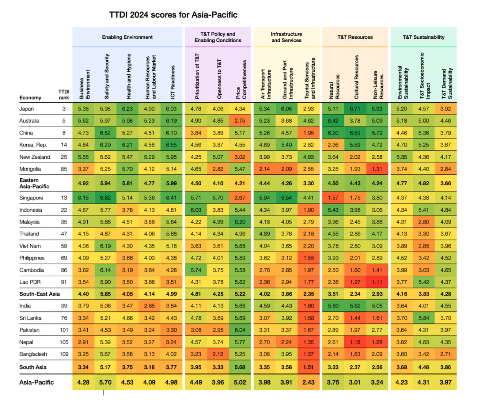
India’s Tourism Competitiveness: Rising Strong in TTDI 2024
India has taken another confident step onto the global tourism stage, securing the 39th position among 119 economies in the World Economic Forum’s Travel & Tourism Development Index (TTDI) 2024. The index, which measures the factors and policies that enable sustainable and resilient tourism development, places India at the very top among South Asian nations and as the best performer in the lower-middle-income group. This ranking highlights India’s resilience and potential as the global travel industry emerges from the shadow of the pandemic.
Globally, the United States, Spain, and Japan lead the list. India’s placement, while below its adjusted 2021 rank of 38th, reflects progress in key areas and the country’s ambition to balance tourism growth with sustainability. The TTDI also shows that while tourism worldwide is recovering, structural challenges like labour shortages, inflation, and uneven infrastructure development remain. India’s score is still slightly below its 2019 pre-pandemic level, but its trajectory is clearly upward.
What truly distinguishes India is its unmatched wealth of resources. The country ranks in the global top 10 across all three resource pillars: 6th in Natural Resources, 9th in Cultural Resources, and 9th in Non-Leisure Resources. Few nations can claim such breadth. From the Himalayas, tiger reserves, and coastal landscapes to world-renowned heritage sites and a thriving MICE (meetings, incentives, conferences, exhibitions) sector, India offers a diversity of experiences that few destinations can match, however many strategies need to be experimented before tourism potential is maximized.
Infrastructure is another area where India’s investments are showing results. The country ranks 18th in price competitiveness, making it one of the world’s best-value destinations, and performs strongly in air transport (26th) and ground and port infrastructure (25th). This is the result of significant expansion in airports, road connectivity, and even the advent of high-speed rail. These improvements are helping to make India more accessible, both for international arrivals and for domestic travelers seeking to explore beyond traditional hotspots.
Government policies have been critical in driving this momentum. Initiatives such as Swadesh Darshan and PRASHAD have strengthened infrastructure in heritage, spiritual, and thematic tourism circuits. At the same time, India is actively building its presence in medical value travel, positioning itself as a hub for affordable, high-quality healthcare and wellness experiences. These measures showcase a holistic vision of tourism that blends heritage with modern development that is heritage with progress.
However, challenges remain. While India excels in resources and competitiveness, the TTDI highlights areas requiring attention. Digital infrastructure and ICT readiness need strengthening to provide travellers with modern, seamless services, from easy e-visas to real-time information. Sustainability is another frontier. With the global conversation shifting toward climate-friendly and community-led tourism, India must expand eco-tourism, support local livelihoods, and integrate conservation into every stage of tourism planning. This is where organizations like TOFT play a crucial role, advocating for responsible wildlife and nature-based tourism models that protect the very landscapes travellers come to experience.
Equally important is inclusivity. Tourism can become a powerful engine for equitable growth, but this requires boosting women’s participation, building skills in rural and semi-urban areas, and ensuring that communities benefit directly from tourism income. India’s price advantage will continue to attract visitors, but moving up the value chain to attract longer-staying, higher-spending travellers will depend on consistently delivering quality, safety, and sustainability.
Looking ahead, global travel trends are shifting. Leisure travel remains dominant, but wellness, nature-based tourism, and experiential travel are growing rapidly. India is uniquely positioned to capture this demand. Its yoga, Ayurveda, and wellness traditions give it an edge in the global health tourism market, while its vast protected areas and biodiversity offer exceptional opportunities for wildlife and eco-tourism. With the right balance of promotion, policy, and protection, these segments can become powerful drivers of India’s next leap in global rankings.
In summary, India’s 39th place in TTDI 2024 is not just a number—it is a reflection of the country’s strengths, opportunities, and challenges. Its natural and cultural wealth make it a global standout, while infrastructure investments and government schemes are paving the way for future growth. The road ahead lies in deepening sustainability, embracing digital innovation, and ensuring inclusivity. For TOFT and its network of conservation-minded travel professionals, these findings are a reminder of why responsible tourism matters more than ever. India’s tourism story is one of heritage meeting progress, but its true success will be defined by how it safeguards its treasures for generations to come.
Reference
https://www3.weforum.org/docs/WEF_Travel_and_Tourism_Development_Index_2024.pdf




